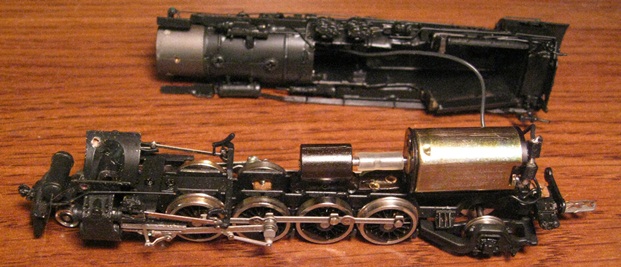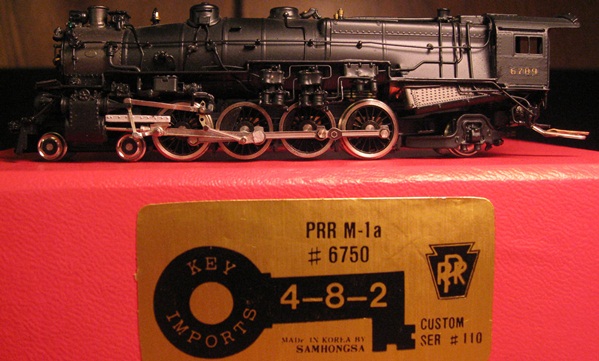

Introduced: 1993
Although this model came out at approximately the same time as the Key/Samhongsa NYC L-4B Mohawk 4-8-2, the two models do not share the same mechanism (despite having the same wheel arrangement) -

The motor is a 3-pole "can" mounted on a torque arm that connects to the worm box. Said worm box is mounted on a leaf spring. Left-rail pickup comes from the six left-side tender wheels, whereas right-rail pickup comes from the four right-side drivers (or at least it's supposed to, but more on that in a moment). Both tender trucks are sprung (whereas the pilot truck is not). Tender current is transferred to the engine by way of a pair of stiff wires on the tender drawbar. The model does have a directional headlight - just not a very good one (being barely visible at normal operating voltages).
As delivered, there are no traction tires. However, a TT-equipped driverset is included in the box should you wish to trade pickup for pulling power. Only the #3 drivers are geared (with the others being turned solely by the cranks). All four driversets ride in square bronze bearing blocks that are fully spring-loaded (each bearing block has an individual coil spring between it and the frame). Wheels are low-profile, so no problems on Code-55 rails. A dummy (non-operational) knuckle coupler is mounted to the pilot. There is no coupler on the tender, although a screw is provided for mounting a Micro-Trains (or whatever) coupler box.
Overall performance is decent (if unspectacular). On the plus side, pulling power is very good (22 freight cars on level track even without the traction tires). The model has no problems negotiating turnouts and curves as sharp as 11"-radius (although any sharper than that and the drivers are derailing). On the down side, the mechanism is geared pretty high (making for iffy performance at the extreme low end of the throttle and a very high top-end speed).
The main problem with these models is their pickup (or lack thereof). No, out and out stalls are not a problem, but rather they tend to run just a bit uneven overall (particularly through curves). The trouble starts with the center two driversets. Being "blind" (IE, flangeless), they are mounted such that they ride ever so slightly off the rails much of the time (IE, most of the right-rail pickup comes solely from the #1 and #4 drivers). Making matters worse, the pilot and trailing trucks are also supposed to collect right-rail current, but... they don't. This being due to the clearcoating applied to the axles and the paint applied to the axle guides (fortunately, clearing away said coatings will go a long way towards improving performance).
The stiff wires on the tender drawbar may be a weak point as well (as is often the case), and if I were interested in operating one of these models I would definitely run an insulated mini-wire from the tender to the motor (after restoring the pilot and trailing truck pickup, that is). Once so modified, these models should run every bit as good as they look.

To remove the locomotive shell, first unscrew the two small screws on the back (cab) end. Next, unscrew the screw underneath the pilot truck. Now the tricky part - there are two handrail pieces that feed through holes in the chassis and then into the smokebox (where the ends are then bent over, preventing one from removing the shell). To free these up, pop the front off of the smokebox. This will reveal the bent wires (which you can then straighten out in order to remove them and free up the boiler).
Grade: B